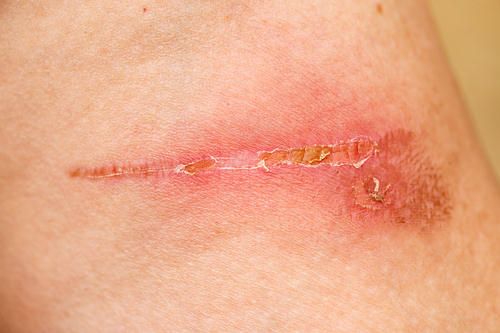What are open and superficial wounds?
Open wounds are injuries that compromise the integrity of the skin, exposing deeper tissues. These include abrasions, cuts, and lacerations. These wounds are usually accompanied by varying degrees of bleeding and require prompt treatment to prevent infection. Superficial wounds primarily affect the surface of the skin, potentially only damaging the epidermis or superficial dermis. Common examples include superficial abrasions and first-degree burns. Although superficial wounds may seem minor, improper treatment can still lead to infection or delayed healing.

How should newly developed open wounds be treated?
Newly formed open wounds require immediate and proper treatment. First, control the bleeding by applying direct pressure to the wound with clean gauze or cloth for 5-10 minutes. If blood seeps through, do not remove the dressing; continue applying more to the existing dressing. After stopping the bleeding, thoroughly rinse the wound with saline solution to remove dirt and bacteria. For deeper wounds, ensure that debris deep within the wound is also cleaned during rinsing. Next, disinfect with povidone-iodine, carefully working outwards in a circular motion to avoid introducing bacteria from surrounding areas. After disinfection, apply a suitable sterile dressing based on the size and location of the wound. For clean-edged cuts, wound adhesive or suture tape may be needed to help align the wound edges.
How can I determine if a wound needs stitches?
Determining whether a wound requires professional suturing involves several factors. Wound depth is a crucial indicator; wounds that penetrate the subcutaneous fat layer or deeper usually require suturing. Wounds longer than 2 cm or wider than 0.5 cm are also recommended for suturing. Even small wounds located on special areas such as joints or the face may require suturing to minimize scarring. Wounds with clearly separated edges that cannot be naturally closed also require professional treatment. Heavily contaminated wounds may require cleaning before deciding whether to suturing. Wounds older than 6-8 hours may require delayed suturing due to increased risk of infection.
What are the key points to pay attention to in daily wound care?
Routine wound care should follow scientific principles. Keeping the wound clean is fundamental; change dressings regularly and avoid contact with dirty water or debris . Observing changes in the wound is important; watch for signs of infection such as increased redness and swelling, increased discharge, unusual odor, or worsening pain. A properly moist environment promotes healing; modern wound care does not recommend allowing the wound to completely dry and scab over. Protect the healthy skin around the wound and avoid excessive tearing when changing dressings. Adequate nutritional support is crucial; ensure sufficient intake of protein, vitamin C, and zinc, as these nutrients are essential for wound healing. Avoid excessive activity of the wound area to prevent it from reopening or delaying healing.
What signs indicate a possible wound infection?
Recognizing early signs of wound infection is crucial. Persistent redness and swelling around the wound, gradually expanding in area, is a common sign of infection. Worsening pain, especially throbbing pain, should raise suspicion. Increased wound discharge, turning yellowish-green or developing pus, accompanied by an unpleasant odor, is a clear sign of infection. Systemic symptoms such as fever, chills, and fatigue indicate the infection may have spread. Stagnant wound healing, failing to improve beyond the expected time, also suggests possible infection. Swollen lymph nodes are a sign the body is fighting infection; painful or swollen lymph nodes in the armpit or groin should prompt immediate medical attention.
How to choose the right wound dressing?
Choosing the right dressing based on the wound's characteristics can significantly promote healing. For wounds with significant exudate, alginate or foam dressings offer good absorption. For superficial wounds with less exudate, hydrocolloid dressings provide a suitable moist environment. For wounds at risk of infection, silver-containing dressings can be considered, as silver ions have broad-spectrum antibacterial properties. For dry wounds, hydrogel dressings can replenish moisture. Wounds in special locations require dressings with good conformation; for example, elastic dressings can be used around joints. The frequency of dressing changes should also be considered; highly absorbent dressings can last longer, reducing the need for frequent changes.
For more information on Innomed®Alginate Dressing, refer to the Previous Articles. If you have customized needs, you are welcome to contact us; You Wholeheartedly. At longterm medical, we transform this data by Innovating and Developing Products that Make Life easier for those who need loving care.
Editor: kiki Jia

 English
English عربى
عربى Español
Español русский
русский 中文简体
中文简体








